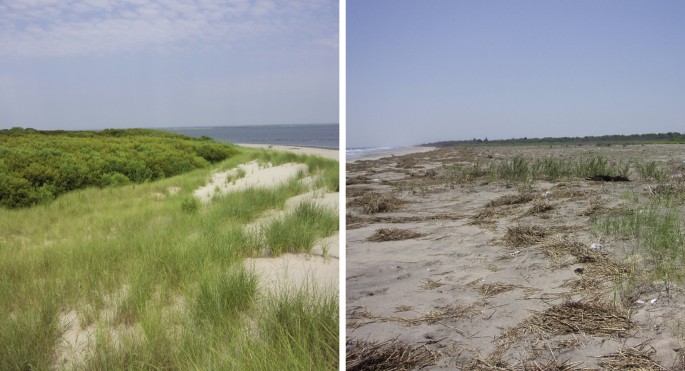
- Select a language for the TTS:
- UK English Female
- UK English Male
- US English Female
- US English Male
- Australian Female
- Australian Male
- Language selected: (auto detect) - EN
Play all audios:
Access through your institution Buy or subscribe To the Editor — Writing in _Nature Climate Change_, Dúran Vinent and Moore1 suggest that barrier islands are intrinsically bistable, existing
in one of two equilibrium states, and that the state can be used to predict island response to climate change. Bistability exists when any system can exist in two distinct states of
equilibrium2. Applied to barrier islands, Dúran Vinent and Moore claim that extrinsic variable changes (that is, reduced sediment supply) alter system parameters (dune-building) and can push
entire islands across a threshold from one equilibrium state to an alternate equilibrium state, from high to low, for example. This results in fundamental changes to system properties and
affects island resilience. However, barrier islands do not function within a dichotomous framework of bistability where 'low' islands are simply an alternate equilibrium state.
This is a preview of subscription content, access via your institution RELEVANT ARTICLES Open Access articles citing this article. * PROBABILISTIC PATTERNS OF INUNDATION AND BIOGEOMORPHIC
CHANGES DUE TO SEA-LEVEL RISE ALONG THE NORTHEASTERN U.S. ATLANTIC COAST * Erika E. Lentz * , Sara L. Zeigler * … Nathaniel G. Plant _Landscape Ecology_ Open Access 07 November 2020 ACCESS
OPTIONS Access through your institution Subscribe to this journal Receive 12 print issues and online access $209.00 per year only $17.42 per issue Learn more Buy this article * Purchase on
SpringerLink * Instant access to full article PDF Buy now Prices may be subject to local taxes which are calculated during checkout ADDITIONAL ACCESS OPTIONS: * Log in * Learn about
institutional subscriptions * Read our FAQs * Contact customer support REFERENCES * Dúran Vinent, O. & Moore, L. J. _Nature Clim. Change_ 5, 158–162 (2015). Article Google Scholar *
Beisner, B. E., Haydon, D. T. & Cuddington, K. _Front. Ecol. Environ._ 1, 376–382 (2003). Article Google Scholar * Hayden, B. P., Santos, M. C. F. V., Shao, G. & Kochel, R. C.
_Geomorphology_ 13, 283–300 (1995). Article Google Scholar * Young, D. R. et al. _Ecosystems_ 10, 854–863 (2007). Article Google Scholar * Brantley, S. T. et al. _PLoS ONE_ 9, e104747
(2014). Article Google Scholar * Hayden, B. P., Dueser, R. D., Callahan, J. T. & Shugart, H. H. _Bioscience_ 41, 310–318 (1991). Article Google Scholar * Zinnert, J. C., Shiflett, S.
A., Vick, J. K. & Young, D. R. _Geocarto Int._ 26, 595–612 (2011). Article Google Scholar * Clovis, J. F. _Castanea_ 33, 115–121 (1968). Google Scholar * Bachmann, C. M. et al. _IEEE
Trans. Geosci. Remote Sens._ 40, 2313–2330 (2002). Article Google Scholar * Stallins, J. A. _Ecol. Complex._ 2, 410–430 (2005). Article Google Scholar Download references AUTHOR
INFORMATION AUTHORS AND AFFILIATIONS * Department of Biology, Virginia Commonwealth University, 1000 West Cary Street, Richmond, 23284, Virginia, USA Julie C Zinnert & Donald R Young *
Joseph W. Jones Ecological Research Center, 3988 Jones Center Drive, Newton, 39870, Georgia, USA Steven T Brantley Authors * Julie C Zinnert View author publications You can also search for
this author inPubMed Google Scholar * Steven T Brantley View author publications You can also search for this author inPubMed Google Scholar * Donald R Young View author publications You can
also search for this author inPubMed Google Scholar CORRESPONDING AUTHOR Correspondence to Julie C Zinnert. RIGHTS AND PERMISSIONS Reprints and permissions ABOUT THIS ARTICLE CITE THIS
ARTICLE Zinnert, J., Brantley, S. & Young, D. Bistability and the future of barrier islands. _Nature Clim Change_ 6, 5–6 (2016). https://doi.org/10.1038/nclimate2802 Download citation *
Published: 23 December 2015 * Issue Date: January 2016 * DOI: https://doi.org/10.1038/nclimate2802 SHARE THIS ARTICLE Anyone you share the following link with will be able to read this
content: Get shareable link Sorry, a shareable link is not currently available for this article. Copy to clipboard Provided by the Springer Nature SharedIt content-sharing initiative







